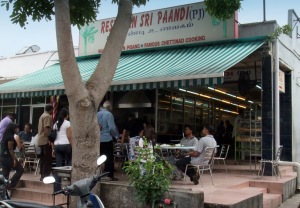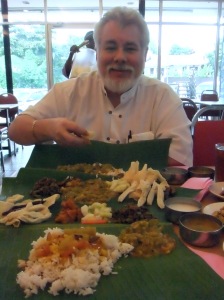Everything you ever wanted to know about eating from a banana leaf. And other things I learned last month.
It was a surprise when we made plans to go to lunch with “JJ”, Derek’s colleague, and I happened to learn that the date chosen was his birthday. That made it all the more special. JJ, an expat American who’s lived in Kuala Lumpur for more than a decade, has been a real help to Derek in getting him oriented–particularly to the unlimited number of seriously multi-story malls selling hectares of electronics goods in Malaysian capital. If there’s something you want, and it’s not in one of the seven-story mega-malls specialising in electronics, well, my thought is that you don’t need it.
Anyway. The very helpful JJ had loaned us an old Windows Mobile phone he wasn’t using so that we could talk to real estate agents and so on. This was enough to cause me to do a happy dance since it was actually an operating system I was familiar with and a file structure, calendar, contacts and whatnot that I could manage.
Given that it was a new country code, most things came in the Malay language until we found the right menu command for ‘English’ AND everything about everything else was quite different, it was comforting to have a phone that seemed somewhat familiar. Fortunately, most vendors recognise this and the nice young woman at the phone company store had scribbled directions on a scrap of paper which enabled us to set the default language to English.
So. Next steps. We got a pay-as-you-go card and worked our way through the various difficulties of sorting out how telecommunications works in a new country, got the thing initialised, made a few calls, sent some text messages and then made this date to go to lunch with JJ. By that time, of course, it was time to get a a pay-as-you-go top up card. Unfortunately, you cannot do that on-line in Malaysia with this carrier (or at least we can’t) so it was off to yet another mall where we would find shops, kiosks and news agents readily selling them.
On the morning of our meeting date, I was fiddling with the phone and confirming the lunch time with Derek, since we would converge on the chosen restaurant at a time that meant I had to get myself organised and find transport from the hotel to said restaurant…when, lo and behold, an alarm window popped up and informed me that it was JJ’s birthday. Well, who would know better than JJ’s own calendar? He hadn’t mentioned it but what an opportunity to repay some of his kindness.
We stopped for a small gift and a card and then zoomed off in the little Proton Waja* rental car, our absolutely essential tomtom GPS, “Gladys”, firmly tethered and with a destination set in her electronic brain to get us to the Restaurant Sri Paandi P.J., Petaling Jaya. JJ had given us a business card — it’s his favourite restaurant — and we were ready to roll.
It was only about fifteen minutes to the restaurant and there we were at Sri Paandi, searching for a parking space at the clearly popular eaterie. JJ arrived at the same time and parked nearby. All right, we were ready for this new experience.
 At last, the banana leaf comes into the picture. This is serious stuff, this banana leaf cuisine. We loved it. Paandi is apparently JJ’s favourite restaurant in the whole wide world and it was easy to see that he was a special and welcomed customer of the Paandi folks, too.
At last, the banana leaf comes into the picture. This is serious stuff, this banana leaf cuisine. We loved it. Paandi is apparently JJ’s favourite restaurant in the whole wide world and it was easy to see that he was a special and welcomed customer of the Paandi folks, too.
The cuisine comes from South India, by the way, and apparently has variations in all the countries to which its made its way over the centuries. But, esssentially, it’s all the same idea and, wherever you are, whether vegetarian or non-it’s got a banana leaf under it all.
Why eat from a banana leaf? It turns out there are several reasons. Among them are that hot food served on a banana leaf takes nutritional and medicinal values of the banana tree, it is said, and this must be a good thing, right? Also, eating from a banana leaf is like eating on a fresh plate at each meal. It’s bio-degradable, unlike plastic plates and ghee and oil do not stick to the banana leaf, making it easier, they say, to enjoy their flavours. If you live where there are banana leaves, you don’t have to pay for tableware and, JJ told me, where it’s part of the local cuisine, the used banana leaves are fed to the cattle. Finally, it’s just plain fun!
We were each given a gigantic green banana leaf, laid out with the spine of the leaf on a horizontal plane. We had no time to ponder this leaf and appreciate its various qualities (see above) because immediately a cadre of helpful servers made their various ways to us and started piling things on our banana leaves, asking questions (which, fortunately, JJ could answer) and making way for the next server. Within seconds, we had rice, curries, fried bitter melon (which I loved), several varieties of chili peppers, other curries…and so on.
The photo (right) says it best: JJ is demonstrating how to pick up a ball of rice-and-curry with three fingers and the banana leaves piled in front of him are his own and mine. He made the mistake of saying that the Chinese normally ask for a fork and spoon so, after I gave it the hands-in try, I eventually asked for a fork and spoon and ate that way.
More side dishes arrived after more servers, questions, decisions and nods. The little dishes to the right in the photo contain dahl soup, fried calamari and many things I confess I’ve forgotten (though I consumed most of them). JJ ordered a side dish of Tandoori chicken with his meal, too, and it looked quite wonderful.
Yes, we pretty much ate it all. It took a while but we enjoyed nearly every bite of it. there wasn’t anything I didn’t like — and several things I thought were really fabulous. It all felt quite healthy and well prepared. At the end of the meal, JJ taught us that the banana leaf should not be left open after finishing the meal but should be folded with the top half covering the bottom half to signify that you have enjoyed your meal and you will visit again. So we were sure to do that.
As it was JJ’s birthday and he’d done so much for us, we picked up the tab. All this food for three hearty appetites, including soft drinks and a couple of rounds of tea? About £7.20 or US$10. It’s easy to see why it’s such a popular way to eat. In fact, we enjoyed it so much that Derek and I went for ‘banana leaf cuisine’ in the area where our hotel was just a few days later. It was a bit more posh, restaurant-wise, nearly as good, though a bit different in the variety, and cost a bit more. But we enjoyed that immensely, too.
We will definitely go back for more. In fact, we’re headed back to Malaysia in early January to (hopefully) move into the house we’ll live in for 2011 and one of the first things we’ll look for is ‘banana leaf cuisine’ in our new neighbourhood.
_____________________________
*I should add here that the Proteon Waja, a trusty little black sedan in our case, is the first Malaysian-designed car. Ever. The name Waja means “tough (as steel)” and reflects the strength of the steel used for the Waja compared with the previous Proton models. The “Waja” name was chosen partly to counter the perception in the domestic market that Proton cars were less strong than other cars. Friends in the UK can keep a lookout for the Proton Impian, the Waja’s English cousin. “Impian” means “dream” in Malay. I have no idea about the strength of the steel used in the Impian, however. You’re on your own there.

Ideally you should experience a bowel movement after every meal but as long as you experience at least one bowel movement a day you are fine.
Eating plenty of fresh fruits and vegetables
while cutting back on the sweets will help
to burn more fat. This gives you the energy to complete your
workout while maintaining a calorie deficit every other day.